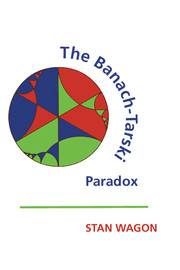Book contents
- Frontmatter
- Contents
- Foreword by Jan Mycielski
- Preface
- Preface to the Paperback Edition
- Part I Paradoxical Decompositions, or the Nonexistence of Finitely Additive Measures
- Chapter 1 Introduction
- Chapter 2 The Hausdorff Paradox
- Chapter 3 The Banach-Tarski Paradox: Duplicating Spheres and Balls
- Chapter 4 Locally Commutative Actions: Minimizing the Number of Pieces in a Paradoxical Decomposition
- Chapter 5 Higher Dimensions and Non-Euclidean Spaces
- Chapter 6 Free Groups of Large Rank: Getting a Continuum of Spheres from One
- Chapter 7 Paradoxes in Low Dimensions
- Chapter 8 The Semigroup of Equidecomposability Types
- Part II Finitely Additive Measures, or the Nonexistence of Paradoxical Decompositions
- Appendix A Euclidean Transformation Groups
- Appendix B Jordan Measure
- Appendix C Unsolved Problems
- Addendum to Second Printing
- References
- List of Symbols
- Index
Chapter 1 - Introduction
from Part I - Paradoxical Decompositions, or the Nonexistence of Finitely Additive Measures
Published online by Cambridge University Press: 05 August 2012
- Frontmatter
- Contents
- Foreword by Jan Mycielski
- Preface
- Preface to the Paperback Edition
- Part I Paradoxical Decompositions, or the Nonexistence of Finitely Additive Measures
- Chapter 1 Introduction
- Chapter 2 The Hausdorff Paradox
- Chapter 3 The Banach-Tarski Paradox: Duplicating Spheres and Balls
- Chapter 4 Locally Commutative Actions: Minimizing the Number of Pieces in a Paradoxical Decomposition
- Chapter 5 Higher Dimensions and Non-Euclidean Spaces
- Chapter 6 Free Groups of Large Rank: Getting a Continuum of Spheres from One
- Chapter 7 Paradoxes in Low Dimensions
- Chapter 8 The Semigroup of Equidecomposability Types
- Part II Finitely Additive Measures, or the Nonexistence of Paradoxical Decompositions
- Appendix A Euclidean Transformation Groups
- Appendix B Jordan Measure
- Appendix C Unsolved Problems
- Addendum to Second Printing
- References
- List of Symbols
- Index
Summary
It has been known since antiquity that the notion of infinity leads very quickly to seemingly paradoxical constructions, many of which seem to change the size of objects by operations that appear to preserve size. In a famous example, Galileo observed that the set of positive integers can be put into a one-one correspondence with the set of square integers, even though the set of nonsquares, and hence the set of all integers, seems more numerous than the squares. He deduced from this that “the attributes ‘equal,’ ‘greater’ and ‘less’ are not applicable to infinite … quantities,” anticipating developments in the twentieth century, when paradoxes of this sort were used to prove the nonexistence of certain measures.
An important feature of Galileo's observation is its resemblance to a duplicating machine; his construction shows how, starting with the positive integers, one can produce two sets, each of which has the same size as the set of positive integers. The idea of duplication inherent in this example will be the main object of study in this book. The reason that this concept is so fascinating is that, soon after paradoxes such as Galileo's were being clarified by Cantor's theory of cardinality, it was discovered that even more bizarre duplications could be produced using rigid motions, which are distance-preserving (and hence also area-preserving) transformations. I refer to the Banach-Tarski Paradox on duplicating spheres or balls, which is often stated in the fanciful form: a pea may be taken apart into finitely many pieces that may be rearranged using rotations and translations to form a ball the size of the sun.
- Type
- Chapter
- Information
- The Banach-Tarski Paradox , pp. 3 - 14Publisher: Cambridge University PressPrint publication year: 1985

